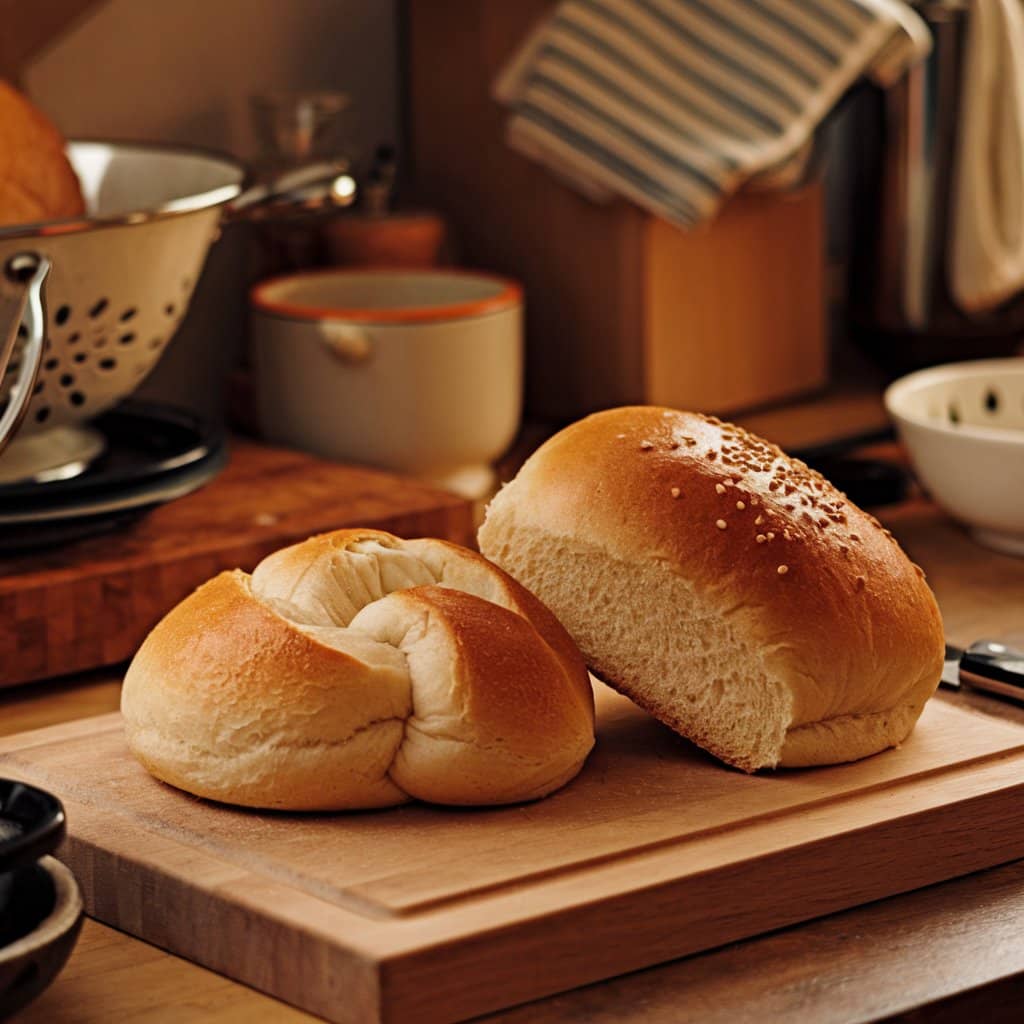Understanding the difference between a bun and a dinner roll is essential when selecting the right bread for your meal. While they may appear similar at first glance, their textures, sizes, uses, and baking methods vary significantly. Buns are typically used for sandwiches and burgers due to their sturdy structure, while dinner rolls are softer and served as a side dish at meals. Recognizing these distinctions can help you choose the perfect bread for any occasion, whether it’s a casual barbecue or a formal holiday dinner. In this guide, we’ll explore their characteristics, culinary uses, and how they differ from each other.
Table of contents
What is a Bun? Understanding the Difference Between a Bun and a Dinner Roll
Buns are a versatile type of bread commonly found in fast food, casual dining, and even gourmet cuisine. They are typically round, soft, and sturdy enough to hold a variety of fillings. The difference between a bun and a dinner roll lies in how they are used in meals. Buns are designed to be a structural component of a dish, often serving as the base for burgers, sandwiches, and pulled pork sliders.
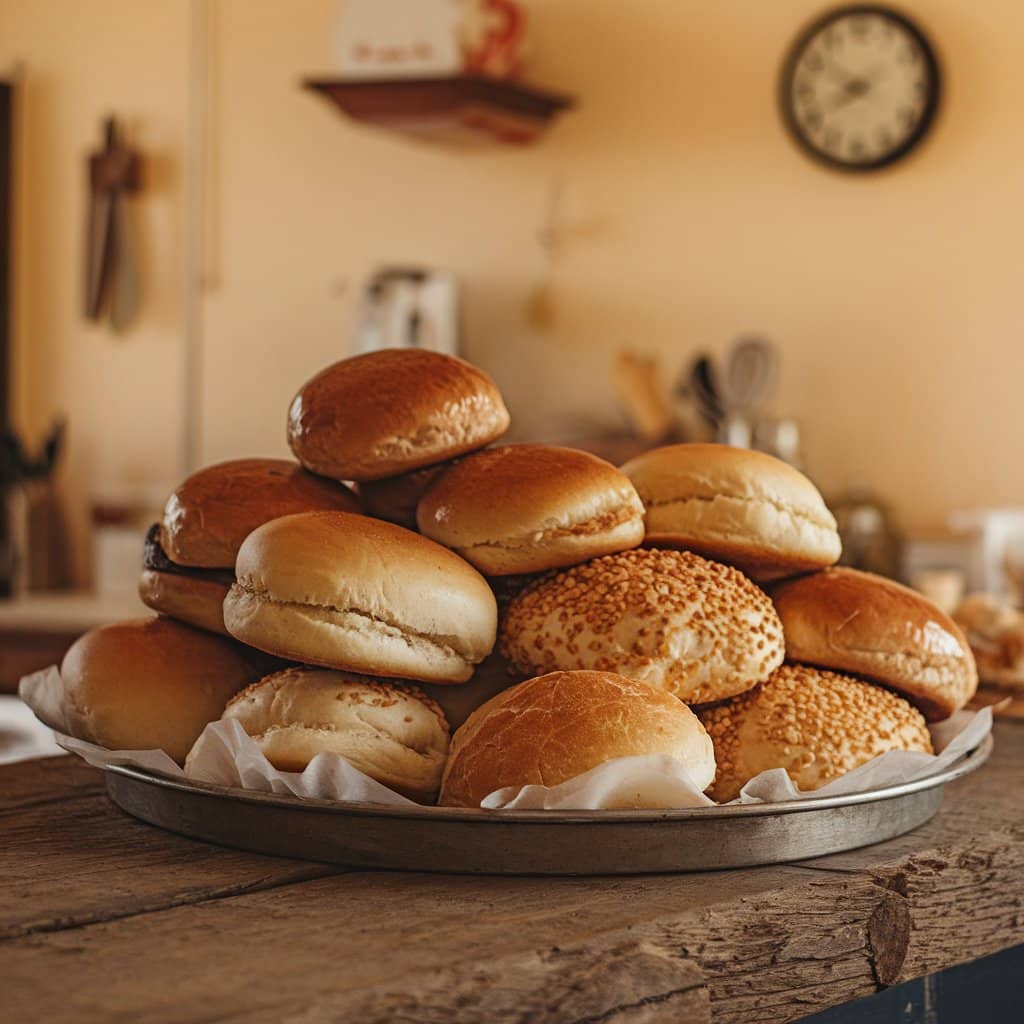
Their slightly sweet and tender crumb complements savory fillings while maintaining enough firmness to prevent sogginess. In contrast, dinner rolls are meant to be a standalone side dish, served alongside main courses like soups, salads, or holiday roasts. This functional distinction is one of the key aspects separating buns from dinner rolls.
Key Features of Buns Explained – How They Differ from Dinner Rolls
One important difference between a bun and a dinner roll is their size and firmness. Buns are generally larger, round, and designed to hold hearty fillings such as burger patties, pulled pork, or deli meats. Their structure is slightly denser and sturdier, allowing them to support toppings, sauces, and condiments without falling apart.
In contrast, dinner rolls are smaller, softer, and fluffier, making them ideal as a side dish rather than a bread base for fillings. Buns are often made with enriched dough containing milk, butter, and eggs, contributing to a richer taste and more substantial texture. This composition makes buns perfect for sandwiches, while dinner rolls are better suited for soaking up sauces and accompanying meals.
- Size and Shape: Buns are usually round and can range from small, single-serving sizes to larger sandwich buns.
- Texture: They are soft, fluffy, and sometimes slightly chewy due to their enriched dough content.
- Taste: Buns have a mild, slightly sweet flavor, though some types can be savory.
Common Types of Buns
- Hamburger Buns: These are larger and sturdy enough to hold burger patties and toppings.
- Hot Dog Buns: Long and split down the middle, they are ideal for sausages and hot dogs.
- Sweet Buns: Examples include cinnamon rolls and brioche buns, often used for desserts.
- Savory Buns: Bao buns and pork buns are examples of savory types commonly found in Asian cuisine.
Popular Examples in Global Cuisines
- Asian Cuisine: Bao buns, filled with savory meats and vegetables.
- European Breads: Brioche buns, known for their buttery richness.
- American Favorites: Classic hamburger and hot dog buns used in fast-food staples.
Buns are not limited to one type of cuisine or meal. Their versatility makes them a favorite for both sweet and savory dishes, from breakfast sandwiches to gourmet burgers.
What is a Dinner Roll? How It Compares to a Bun in Baking and Use
When considering the difference between a bun and a dinner roll, dinner rolls stand out for their lighter, softer texture and smaller size. They are commonly served as a side dish at family meals, holiday feasts, and formal dinners. Unlike buns, which are often baked individually, dinner rolls are typically baked close together in a baking pan. This technique creates a “pull-apart” texture, with soft sides that stay moist and tender.
Dinner rolls are designed to complement main dishes rather than serve as a base for fillings. Their mildly sweet, buttery flavor enhances soups, salads, and roasted meats. This makes dinner rolls a go-to bread for occasions where a soft, comforting bread option is desired.
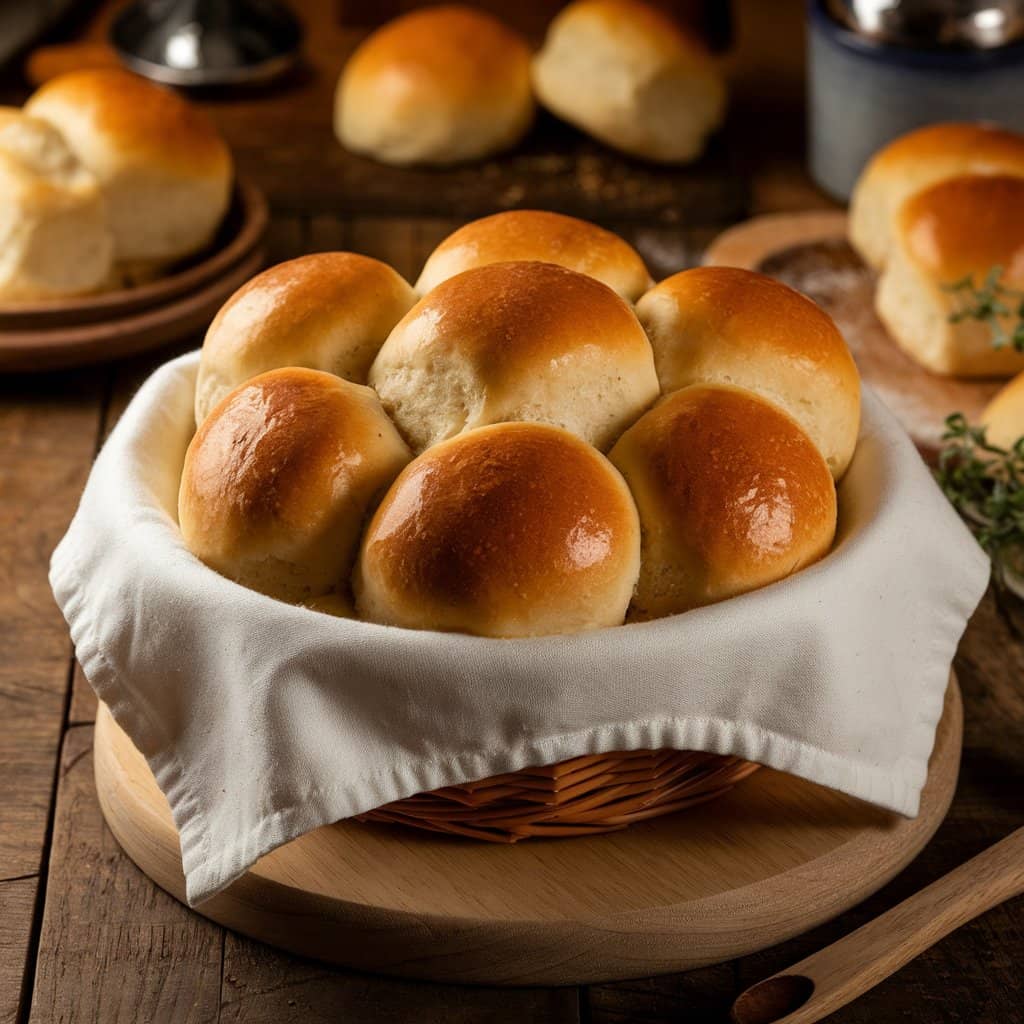
Key Features of Dinner Rolls
- Size and Shape: Dinner rolls are usually small, round, or oval, making them perfect for individual servings.
- Crust and Texture: They have a thin, golden-brown crust with a soft, airy interior.
- Flavor: Dinner rolls are mild in taste, with a slightly sweet or buttery flavor, depending on the recipe.
Ingredients of a Classic Dinner Roll
The dough for dinner rolls typically includes:
- Flour: All-purpose or bread flour for structure.
- Yeast: Helps the dough rise.
- Milk or Water: Adds moisture.
- Butter or Oil: For richness and tenderness.
- Eggs (Optional): For added flavor and a richer texture.
- Sugar and Salt: To balance sweetness and enhance taste.
Common Serving Occasions
- Holiday Dinners: Thanksgiving, Christmas, and Easter meals often feature dinner rolls.
- Formal Events: They are a common accompaniment at weddings and banquets.
- Everyday Meals: Dinner rolls complement soups, stews, and roasted meats.
Types of Dinner Rolls
- Parker House Rolls: Known for their buttery layers and folded shape.
- Cloverleaf Rolls: Shaped like three small dough balls joined together.
- Pull-Apart Rolls: Baked together in a pan and separated when served.
- Whole Wheat Rolls: A healthier option with a nuttier flavor.
Dinner rolls are beloved for their soft, melt-in-your-mouth texture, making them a must-have on dinner tables around the world.
Key Differences Between Buns and Dinner Rolls
The difference between a bun and a dinner roll becomes clearer when comparing their size, texture, and baking methods. Buns are typically larger, firmer, and denser, making them ideal for holding fillings like burgers, pulled pork, or sandwich ingredients. Their sturdiness helps them maintain structure even with heavy or juicy toppings.
In contrast, dinner rolls are smaller, softer, and often slightly sweeter. Their light, fluffy interior and thin, golden-brown crust make them perfect for serving as a side dish. Dinner rolls are typically baked close together, allowing their sides to remain soft and pull apart easily. Meanwhile, buns are usually baked separately on a baking sheet, allowing for even browning all around.
These differences highlight how each bread type serves a specific culinary purpose, making both essential in different dining settings.
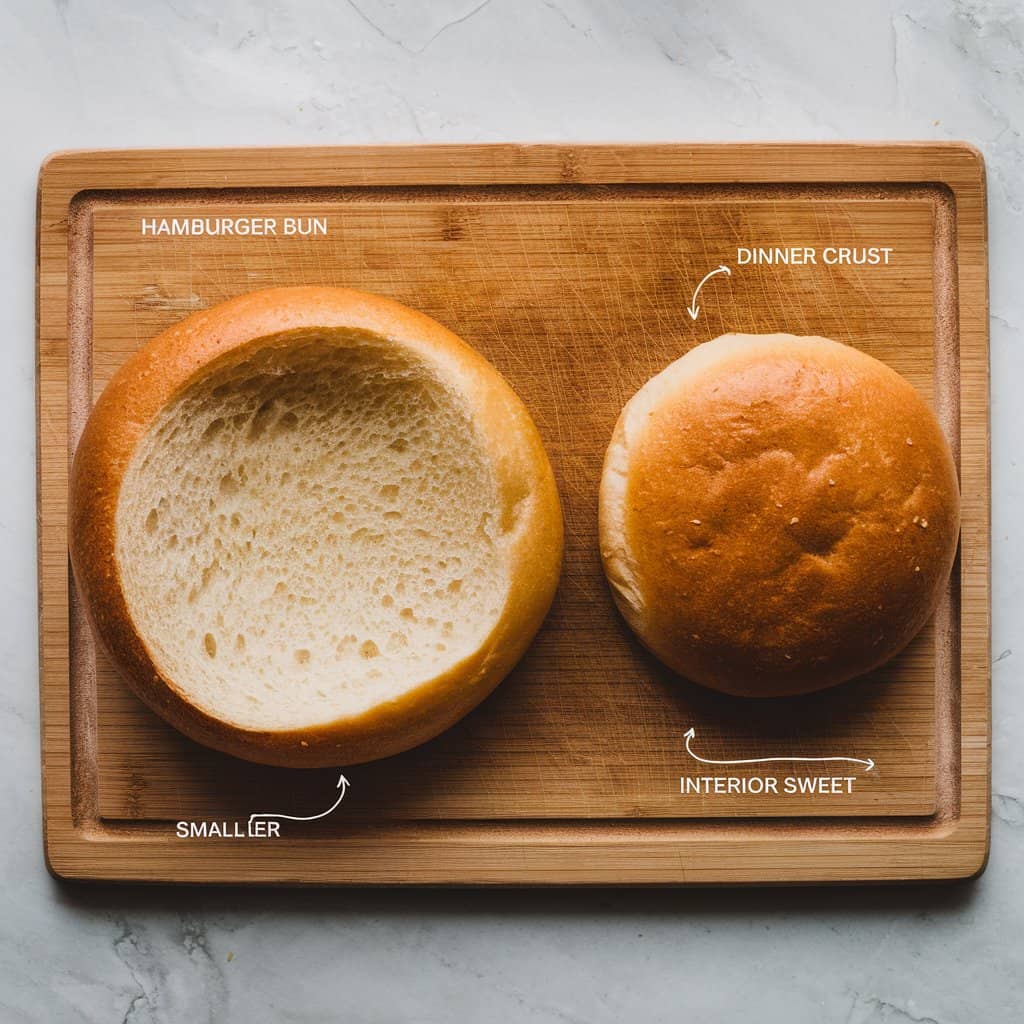
1. Size and Shape Differences
- Buns:
- Usually larger and round.
- Designed to hold fillings, such as meats, cheeses, and sauces.
- Common examples include hamburger and hot dog buns, which are tailored to specific food shapes.
- Dinner Rolls:
- Typically small, single-serving portions.
- Round, oval, or sometimes shaped creatively (e.g., cloverleaf rolls).
- Intended as a side dish rather than a bread for fillings.
2. Texture and Softness Comparison
- Buns:
- Often have a denser texture to support fillings.
- Their crust is soft but firmer than that of dinner rolls.
- Dinner Rolls:
- Airy and light inside, with a thin, soft crust.
- The tenderness makes them perfect for soaking up gravies and sauces.
3. Baking Methods and Recipes
- Buns:
- Baked separately on a tray, allowing full crust development.
- Recipes may include more sugar and eggs for added richness.
- Dinner Rolls:
- Frequently baked close together in a pan, creating pull-apart rolls with soft sides.
- Often brushed with melted butter for added softness and shine.
4. Common Uses in Meals
- Buns:
- Used as a base for sandwiches, burgers, and hot dogs.
- Essential for fast food and casual meals.
- Dinner Rolls:
- Served as a side dish during formal dinners, holiday meals, and special occasions.
- Eaten with soups, salads, or hearty main courses.
Best Culinary Uses for Buns and Dinner Rolls – Meal Pairing Guide
Another key difference between a bun and a dinner roll lies in how they are served and paired with meals. Buns are designed for heartier, filling-based meals. They work best in sandwiches, burgers, and sliders because of their firm structure, which can hold toppings, sauces, and meats without falling apart. Buns are commonly used in casual or fast-food settings, as well as at barbecues and picnics.
On the other hand, dinner rolls are perfect for more formal dining settings. Their soft, pillowy texture makes them ideal for soaking up sauces, gravies, and soups. They are frequently served alongside holiday feasts like Thanksgiving, Christmas, and Easter, complementing dishes like roasted meats, mashed potatoes, and casseroles. Dinner rolls add a comforting, home-baked touch to any meal, making them a staple at special family gatherings and celebrations.
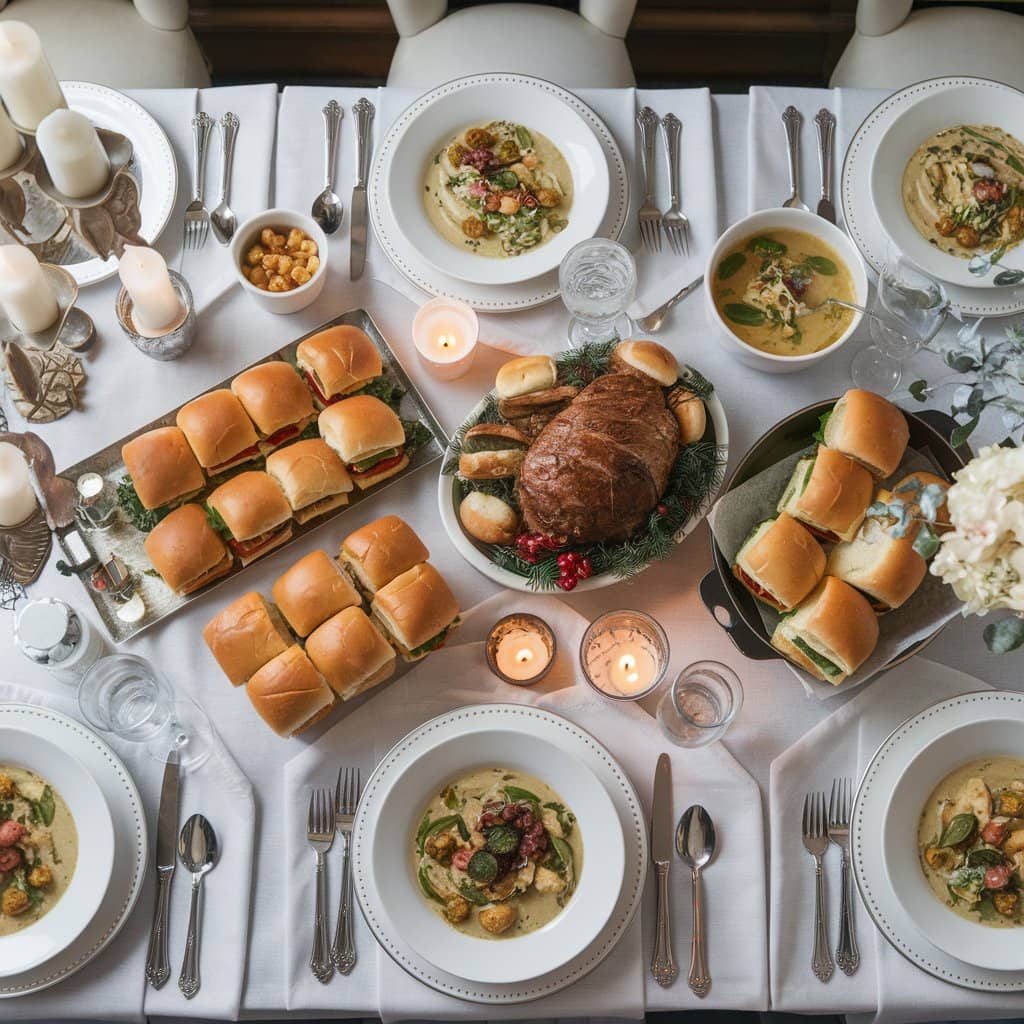
Best Meals for Buns
Buns are designed to hold fillings and are commonly used in sandwiches and snacks. Their firm yet soft texture allows them to support ingredients without falling apart.
- Main Course Pairings:
- Burgers: Classic hamburger buns are perfect for beef, chicken, or veggie burgers.
- Hot Dogs and Sausages: Long hot dog buns complement sausages and bratwursts.
- Pulled Pork Sandwiches: Soft buns soak up juicy fillings like pulled pork or brisket.
- Breakfast Options:
- Breakfast Sandwiches: Fill with eggs, bacon, and cheese.
- Sweet Buns: Enjoy cinnamon buns or brioche for a sweet morning treat.
- Global Dishes:
- Bao Buns: Serve with savory fillings like pork belly or tofu in Asian cuisines.
- Sliders: Mini-buns for bite-sized sandwiches at parties or events.
Best Meals for Dinner Rolls
Dinner rolls shine as a side dish, enhancing a wide range of meals. Their light texture makes them ideal for dipping, spreading, or simply enjoying on their own.
- Formal Dinners:
- Thanksgiving Dinner: Served with turkey, gravy, and cranberry sauce.
- Christmas Feast: Complements roasted meats, stuffing, and vegetables.
- Soups and Stews:
- Creamy Soups: Dip rolls into creamy tomato or butternut squash soup.
- Hearty Stews: Perfect for soaking up rich broths from beef stew or chicken pot pie.
- Salads and Light Meals:
- Caesar Salad Pairing: Adds a satisfying carb element to salads.
- Brunch or Tea Time: Serve with butter, jam, or honey alongside light beverages.
How to Serve for Maximum Enjoyment
- Warming Tips:
- Warm buns slightly for sandwiches to enhance softness.
- Reheat dinner rolls in the oven wrapped in foil to retain moisture.
- Spread Options:
- Serve buns with savory spreads like mayonnaise or barbecue sauce.
- Offer dinner rolls with butter, garlic spread, or honey for extra flavor.
- Creative Presentations:
- Use decorative baskets or trays for dinner rolls at formal dinners.
- Create a “build-your-own” sandwich bar using buns at casual gatherings.
Whether used as the base for hearty sandwiches or served alongside elegant meals, buns and dinner rolls offer delicious options for every dining occasion.
How to Make Buns and Dinner Rolls at Home
For those who enjoy baking, making buns and dinner rolls at home is a rewarding experience. While the ingredients are similar, the techniques and baking processes differ slightly. Here’s a step-by-step guide for baking both.
1- Baking Buns at Home
- Ingredients:
- 4 cups of all-purpose flour
- 2 1/4 tsp active dry yeast
- 1 cup warm milk
- 1/4 cup sugar
- 1/4 cup butter (melted)
- 1 egg (beaten)
- 1 tsp salt
- Instructions:
- Activate the Yeast: Mix warm milk, sugar, and yeast in a bowl. Let it sit for 5-10 minutes until bubbly.
- Make the Dough: Add butter, egg, and salt to the yeast mixture. Gradually add flour while mixing until a soft dough forms.
- Knead the Dough: Knead the dough for about 8-10 minutes until smooth and elastic.
- First Rise: Cover and let rise in a warm place for about 1 hour, or until doubled in size.
- Shape the Buns: Divide the dough into equal portions, shaping them into round buns.
- Second Rise: Place the buns on a baking sheet and let rise for another 30 minutes.
- Bake: Preheat oven to 375°F (190°C) and bake for 15-18 minutes until golden brown.
- Cool and Serve: Let the buns cool before serving or using them for burgers and sandwiches.
2- Baking Dinner Rolls at Home
- Ingredients:
- 4 cups of bread flour
- 2 1/4 tsp active dry yeast
- 1 cup warm milk
- 1/4 cup sugar
- 1/4 cup butter (softened)
- 2 eggs (room temperature)
- 1 tsp salt
- Instructions:
- Activate the Yeast: Combine warm milk, sugar, and yeast in a mixing bowl. Allow it to sit for 5-10 minutes until frothy.
- Mix the Dough: Add eggs, butter, and salt to the yeast mixture. Gradually add flour while mixing until the dough forms a ball.
- Knead the Dough: Knead for 8-10 minutes until smooth and elastic.
- First Rise: Cover the dough and let it rise in a warm place for 1 hour or until doubled in size.
- Shape the Rolls: Divide the dough into small balls and arrange them on a greased baking dish.
- Second Rise: Let the rolls rise again for 30-40 minutes.
- Bake: Preheat the oven to 375°F (190°C). Bake for 15-18 minutes or until golden brown.
- Brush with Butter: After baking, brush the rolls with melted butter for extra softness.
3- Baking Tips for Success
- Proper Measuring: Use a kitchen scale for precise measurements.
- Room Temperature Ingredients: Ensure eggs and milk are at room temperature for better yeast activation.
- Kneading Time: Knead the dough until it’s smooth and elastic for the best texture.
- Warm Environment: Let the dough rise in a warm, draft-free place to speed up fermentation.
- Storage: Store leftover buns and rolls in an airtight container or freeze for long-term storage.
FAQs About Buns and Dinner Rolls
1. Are Buns Healthier Than Dinner Rolls?
It depends on the ingredients used. Buns tend to have more sugar, fat, and calories due to their enriched dough, especially if they are sweetened or contain fillings. Dinner rolls, often made with simpler ingredients, can be lighter but still calorie-dense if brushed with butter or served in large quantities.
2. Can You Substitute Buns for Dinner Rolls?
Yes, but the experience will differ. Buns are larger, firmer, and better suited for sandwiches or burgers, while dinner rolls are softer and meant as a side dish. Substitution is best when texture and size aren’t crucial to the meal.
3. Are All Buns Sweet?
No, not all buns are sweet. While brioche and cinnamon buns are sweetened, many buns like hamburger or hot dog buns are savory and mildly sweetened to enhance their versatility.
4. Why Are Dinner Rolls Served in Baskets?
Dinner rolls are traditionally served in baskets to keep them warm and organized. Wrapping them in a clean cloth inside the basket helps retain heat and prevents them from drying out.
5. Are Dinner Rolls Gluten-Free?
Most dinner rolls are made with wheat flour, making them unsuitable for gluten-free diets. However, gluten-free rolls made from alternative flours like rice or almond flour are widely available.
6. What Makes a Perfect Dinner Roll?
The perfect dinner roll should be soft, fluffy, and slightly golden on top. A balanced recipe using milk, butter, and yeast creates a tender texture with a light sweetness. Proper proofing and baking are essential for achieving the ideal rise and softness.
7. What Is the Main Difference Between a Bun and a Dinner Roll?
The primary difference between a bun and a dinner roll lies in their intended purpose and culinary function. Buns are specifically designed to hold fillings such as meats, cheeses, and vegetables, making them essential for dishes like burgers, sandwiches, and hot dogs. Their size and firmer structure provide stability for heavier toppings and sauces.
In contrast, dinner rolls serve as a complementary side dish, typically paired with main courses like roasted meats, soups, and salads. Their soft, tender texture makes them perfect for soaking up gravies, spreads, and butters. While buns play a central role in a meal, dinner rolls enhance the overall dining experience by adding a light, comforting bread option.
Conclusion
Buns and dinner rolls may share common ingredients, but their textures, shapes, and culinary uses make them distinct bread types. Buns are ideal for holding fillings in sandwiches and burgers, while dinner rolls are perfect side dishes that enhance formal and casual meals alike. Choosing between the two comes down to the type of meal you’re preparing and the overall dining experience you want to create.
Whether you’re making sliders for a party or serving freshly baked dinner rolls at a family gathering, understanding these differences can help elevate your next meal with the right bread choice.

